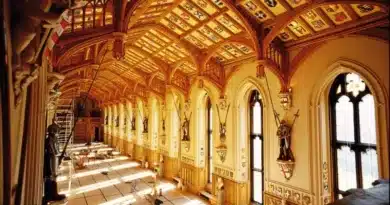How Far Is Windsor Castle from London?
Key Takeaways
| Key Area | Details |
|---|---|
| Distance | 22 to 30 miles from Central London to Windsor Castle, varying by route. |
| Travel Options | Car, train, cycling, walking. Each has different distances and time factors. |
| Driving Routes | Three main routes: Via A4 & M4, Via M4, Via A40. Travel time: 54 mins to 1 hr 10 mins. |
| Driving Delays | Traffic congestion, toll zones, roadworks, and local traffic in Windsor. |
| Train Journey | Fastest: 50 minutes (Paddington to Slough, transfer to Windsor); Slowest: Up to 1 hr 30 mins with multiple transfers. |
| Train Delays | Possible due to train delays, transfer times, and peak-hour crowding. |
| Walking Distance & Time | Routes: 22.2 to 23.7 miles, approximately 8 hours 14 minutes to 8 hours 46 minutes. |
| Walking Delays | Physical fatigue, weather conditions, navigation challenges. |
| Cycling Routes | Three main routes: Via Grand Union Canal (27.4 miles), Via A4 (25.0 miles), Via A4020 (24.4 miles). |
| Cycling Delays | Traffic conditions, road surfaces, weather impacts. |
| Conclusion | Each mode of travel has unique challenges and time delays. Careful planning is essential for a smooth journey. |
Let’s discuss in detail:
Introduction
Windsor Castle, the world’s oldest and largest occupied castle, holds a distinguished place in British history. Located in Windsor, Berkshire, the castle is a significant historical landmark and a popular tourist destination, drawing visitors from around the globe. For those planning to visit Windsor Castle from London, understanding the distance, travel options, and potential time delays is crucial for a smooth and enjoyable journey.
Distance and Travel Options from London to Windsor Castle
Windsor Castle is approximately 22 to 30 miles from central London, depending on the route and mode of transportation chosen. The journey can be made by car, train, cycling, or even on foot, each offering a unique experience. However, the time to reach the castle can vary significantly due to traffic, road conditions, and transportation schedules.
By Car
Driving from London to Windsor Castle is a popular choice for those who prefer convenience and flexibility. The distance between London and Windsor Castle by car ranges from 22.5 miles to 29.7 miles, depending on the route. Here are three main driving routes, along with the estimated travel times and potential delays associated with each:
1. Via A4 and M4 (22.5 miles, approximately 54 minutes):
Starting from central London, this route involves navigating through several toll zones, particularly around Trafalgar Square, Piccadilly, and Knightsbridge. These toll zones can slow down the journey, especially during peak hours.
The route continues onto the A4 and M4, where traffic congestion, particularly near Hammersmith and on the M4 towards Heathrow, can cause delays.
Exiting the M4, the journey proceeds through Langley and Datchet before reaching Windsor. The final approach to Windsor Castle may involve navigating through local traffic, particularly in the historic town centre, which can be busy with tourists and residents.

2. Via M4 (24.5 miles, approximately 1 hour 7 minutes):
This route also begins in central London, following a path similar to the first but diverging at Trafalgar Square, where it turns onto Regent Street and Marylebone Road.
The A40 is the main artery for this route, leading to the M4. Traffic on the A40 and Westway can be heavy, particularly during rush hours.
After joining the M4, the journey is relatively straightforward until the exit for Colnbrook and Datchet. As with the first route, local traffic near Windsor Castle can add to the travel time.
3. Via A40 (29.7 miles, approximately 1 hour 10 minutes):
This route is slightly longer and takes drivers through the A40 and Western Avenue, eventually merging onto the M40 before joining the M25 and M4.
The A40 can be congested, especially around the Western Avenue stretch. The M25, one of the UK’s busiest motorways, can also experience significant traffic delays.
The final leg of the journey involves navigating through the outskirts of Slough before reaching Windsor, where local traffic conditions can impact the total travel time.
Time Delaying Factors When Driving
Several factors can contribute to delays when driving from London to Windsor Castle. These include:
- Traffic Congestion: Central London is notorious for heavy traffic, especially during peak hours. Major roads like the A4, A40, and M4 are frequently congested, particularly around key junctions and roundabouts.
- Toll Zones: Navigating through various toll zones in central London can add time to the journey. The process of entering and leaving toll zones, combined with traffic, can be time-consuming.
- Roadworks: Ongoing roadworks on major routes like the M4 can cause significant delays. It is advisable to check for any planned roadworks before starting the journey.
- Local Traffic in Windsor: As a popular tourist destination, Windsor often experiences heavy traffic, particularly around the town centre and near the castle. Parking can also be challenging, especially during peak tourist seasons.
By Train
Travelling by train from London to Windsor is convenient for those who prefer to avoid driving. Depending on the train service and the departure station, the journey can take anywhere from 5 minutes to 1 hour and 30 minutes.
Fastest Option (50 minutes):
The fastest train route from London to Windsor involves a direct train service from London Paddington to Slough, followed by a quick transfer to Windsor & Eton Central. This route is highly efficient, but the availability of such fast services can be limited.

Slower Options (Up to 1 hour 30 minutes):
Other train services may involve multiple transfers or stops, significantly increasing the travel time. Delays can occur due to train schedules, platform changes, or unexpected service disruptions.
Time Delaying Factors When Taking the Train
When travelling by train, several factors can cause delays:
- Train Delays: Train services can be delayed due to a variety of reasons, including signal failures, track maintenance, or operational issues.
- Transfers: If the train journey involves transfers, particularly at busy stations like Slough, the time taken to switch trains can add to the overall travel time.
- Crowds: During peak hours, trains can be crowded, and finding a seat might be difficult. This can make the journey less comfortable and potentially longer if waiting for a less crowded train.
Walking
Walking from London to Windsor Castle is an option for the adventurous and those interested in a unique experience. The distance, ranging from 22.2 miles to 23.7 miles, can take approximately 8 hours and 14 minutes to 8 hours and 46 minutes, depending on the route.
Via A4 (22.2 miles, approximately 8 hours 14 minutes):
This route takes walkers through central London, following the A4 past landmarks like The Mall and Kensington Road before heading west through Chiswick and Hounslow.
The path continues along the A4, passing through suburban areas before reaching Windsor. The walk is long and demanding, requiring good physical fitness and stamina.

Via A4020 and A4 (23.4 miles, approximately 8 hours 40 minutes):
This route diverges slightly, following the A4020 through areas like Notting Hill, Shepherd’s Bush, and Acton before joining the A4.
The walk includes a mix of urban and suburban environments, with various parks and green spaces.
Via A4020 (23.7 miles, approximately 8 hours 46 minutes):
The longest walking route takes a more northerly path, following the A4020 through Uxbridge before heading southwest towards Windsor.
This less direct route offers a different perspective on London’s outskirts and the Windsor approach.
Time Delaying Factors When Walking
Walking such a long distance presents several potential delays:
- Physical Fatigue: Walking for over 8 hours is physically demanding, and fatigue can slow the pace, particularly towards the end of the journey.
- Weather Conditions: Rain, wind, or extreme heat can significantly impact the speed and comfort of the walk. Adverse weather conditions may require additional breaks or even force a change in plans.
- Navigation Challenges: Navigating through urban areas, especially in unfamiliar parts of London, can lead to wrong turns or delays in finding the correct path.
Cycling
Cycling is a popular and environmentally friendly option for those looking to cover the distance between London and Windsor Castle. The cycling distance ranges from 24.4 miles to 27.4 miles, with travel times of approximately 2 hours and 14 minutes to 2 hours and 28 minutes.
Via Grand Union Canal Walk (27.4 miles, approximately 2 hours 28 minutes):
This scenic route follows the Grand Union Canal, offering a more tranquil and picturesque ride than busy roads.
The path includes several sections where the canal towpath may be narrow or uneven, requiring careful navigation.

Via Great West Rd/A4 (25.0 miles, approximately 2 hours 14 minutes):
This route follows the A4, a major road that connects London to Windsor. The path is relatively direct but involves cycling alongside busy traffic.
Cyclists must navigate several roundabouts and junctions, particularly around Hammersmith and Heathrow.
Via A4020 (24.4 miles, approximately 2 hours 16 minutes):
This route takes cyclists through suburban areas, following the A4020 before joining the A4 near Slough.
The path includes several steep inclines and busy roads, which can slow down the pace.
Time Delaying Factors When Cycling
Cycling from London to Windsor Castle can be delayed by several factors:
- Traffic Conditions: Cycling alongside busy roads like the A4 can be challenging, particularly during peak hours. Traffic congestion can slow down the ride, especially at roundabouts and junctions.
- Road Surface: Uneven or poorly maintained roads, especially along the canal path, can impact cycling speed and comfort.
- Weather: Windy or rainy conditions can make cycling more difficult and slower, requiring additional effort and potentially more breaks.
Conclusion
Travelling from London to Windsor Castle offers a range of options, each with its own challenges and potential delays. Whether driving, taking the train, cycling, or even walking, understanding the distance and factors affecting travel time is essential for planning a successful visit. By considering these factors and choosing the most suitable mode of transportation, visitors can ensure a smooth and enjoyable journey to one of the UK’s most iconic landmarks.
FAQ
What is the distance from London to Windsor Castle?
Windsor Castle is situated about 21 miles (34 kilometres) west of central London. This proximity makes it important to consider convenient travel options, including train, bus, and car, which facilitate day trips to explore the castle’s rich history and architecture.
How long does it take to drive from London to Windsor Castle?
Driving from London to Windsor Castle typically takes around 34 minutes, covering approximately 23 miles. However, travel times can vary due to traffic conditions, especially during peak hours. We advise checking real-time traffic updates before starting your journey.
Which train station in London serves Windsor Castle?
Trains to Windsor Castle depart from London Paddington Station, requiring a change at Slough to reach Windsor & Eton Central Station. Alternatively, direct trains run from London Waterloo to Windsor & Eton Riverside Station. Both Windsor stations are within walking distance of the castle, with Windsor & Eton Central being slightly closer.
How long is the train journey from London to Windsor Castle?
The train journey from London Paddington to Windsor & Eton Central, with a change at Slough, takes approximately 30 to 40 minutes. Direct trains from London Waterloo to Windsor & Eton Riverside take about 54 minutes. These durations can vary slightly depending on the specific service and time of day.
Is there a direct train from London to Windsor Castle?
Yes, direct trains run from London Waterloo to Windsor & Eton Riverside Station, taking approximately 54 minutes. This service is vital for those who prefer a convenient option without changing trains, and the station is a short walk from the castle.
How much does a train ticket from London to Windsor Castle cost?
Train fares from London to Windsor Castle vary depending on the time of travel and booking method, typically ranging from £7 to £45. We advise booking in advance and travelling during off-peak hours, which can often result in lower prices. It is important to check with the train operator for the most accurate and up-to-date fare information.
Can I take a bus from London to Windsor Castle?
Yes, direct buses operate from London Victoria to Windsor, with the journey taking approximately 1 hour and 40 minutes. This option may be more economical, though it is slower than train travel. The bus service provides a scenic route, passing through various towns and countryside.
How much does a bus ticket from London to Windsor Castle cost?
Bus tickets from London to Windsor Castle are generally affordable, with some services costing around £3. Prices can vary based on the bus operator and booking time. Booking tickets in advance or online is important to secure the best savings.
Are there guided tours from London to Windsor Castle?
Yes, numerous guided tours operate from London to Windsor Castle, often including additional attractions like Stonehenge or Bath. These tours provide transportation, expert commentary, and sometimes priority access, enhancing the visitor experience. We recommend reviewing tour itineraries and inclusions to select your best interests.
Is Windsor Castle accessible by public transport from London?
Yes, Windsor Castle is easily accessible from London via train or bus, with daily regular services. The efficient public transport links make it convenient for visitors to plan a day trip without needing a car. Checking timetables and service frequencies in advance is vital.
How far is Windsor Castle from Heathrow Airport?
Windsor Castle is approximately 8 miles (13 kilometres) from Heathrow Airport, making it a convenient visit for travellers with layovers or those arriving in London. Taxi services and public transport options are available to facilitate the short journey between the airport and the castle.
Can I visit Windsor Castle and return to London in a day?
Yes, visiting Windsor Castle from London and returning the same day is entirely feasible. Travel times range from 30 minutes to an hour each way. This allows ample time to explore the castle and its grounds before returning to London. We advise planning your visit early in the day to maximise your experience.
What are Windsor Castle’s opening hours?
Windsor Castle’s opening hours vary seasonally, so it is important to check the official Royal Collection Trust website for the most current information. Generally, the castle opens at 10:00 AM, with the last admissions between 3:00 PM and 4:00 PM, depending on the time of year. The castle may also close for official events, so verifying in advance is necessary.
Do I need to book tickets in advance for Windsor Castle?
While not mandatory, we strongly recommend booking tickets in advance for Windsor Castle to ensure availability and expedite entry. Advance booking can also provide access to any special exhibitions or tours and may offer cost savings compared to purchasing on the day.









